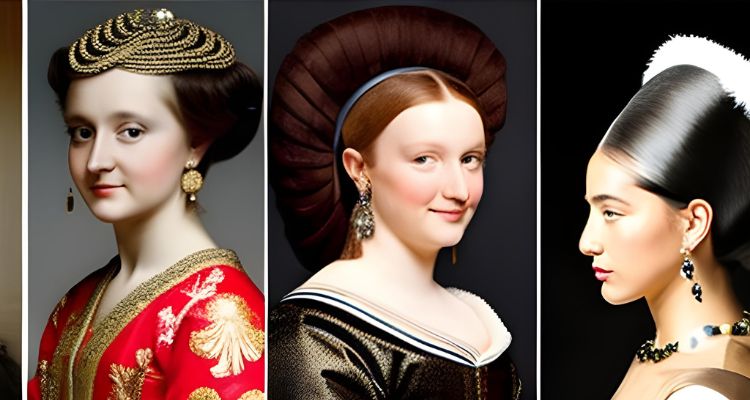If you’re passionate about fashion, it’s essential to Discover the Fashion of the 1560s, an iconic era of considerable social and political change in Europe. By researching past trends, you can gain a deeper understanding of fashion history and the cultural, societal, and economic forces that shaped it. In this paper, we’ll explore the factors that influenced 1560s fashion, from common clothing worn by men and women to frequently used accessories and haircuts. We’ll also examine how the 1560s dress influenced current design and why comprehending historical fashion is vital to producing groundbreaking and influential fashion today.
I. Influences on 1560s Fashion
Every era’s fashion trends are influenced by a wide range of elements, such as historical advances, societal shifts, and economic advancements. The Protestant Reformation increased worldwide trade and exploration, and the creation of strong kingdoms all occurred during the 1560s, a period of enormous change in Europe. Fashion styles, which mirrored the era’s altering ideals and ambitions, were significantly impacted by these shifts.
The emergence of Protestantism, which rejected many of the extravagant displays of wealth and decoration that had marked Catholic design in earlier times, had a significant impact on 1560s fashion. As a result, fashion started to become more austere and straightforward, emphasizing utility over ornamentation.

The rise of international trade and exploration, which brought new materials and fashions from remote lands, was another significant factor in shaping 1560s fashion. Silk, for instance, had a meteoric rise in popularity during this time as European traders created new trading channels with the Ottoman Empire and other Asian superpowers. Bright, striking designs and patterns were increasingly fashionable as a result of the arrival of new materials and fashions from Africa and the Americas.
The advent of powerful dynasties like the Tudor dynasty in England and the Valois dynasty in France had a significant impact on fashion in the 1560s. The era’s principal trendsetters were royalty and nobles, with court fashion frequently setting the bar for the rest of society. From voluminous skirts to complex embroidery and beading, the lavish, elaborately adorned attire worn by kings and their courts served as inspiration for a broad variety of fashion trends.
II. Men’s Fashion
Men’s fashion in the 1560s was defined by a move towards simpler, more functional forms that mirrored Protestantism’s growing influence and the era’s shifting ideals. Men’s clothing of the time had a variety of unique designs and trends, although being typically less flashy than women’s clothing.
In the 1560s, the doublet—a form-fitting jacket worn over a shirt or chemise—was a crucial component of men’s attire. Usually constructed of wool, silk, or velvet, doublets were frequently padded or quilted for warmth. They were worn with a variety of other outfits, such as a hose (tight-fitting pants) and various kinds of cloaks and capes.

Men’s fashion in the 1560s tended to be quite muted in terms of hues and patterns, with dark hues like black, brown, and navy blue being especially well-liked. Instead of the lavish stitching and ornamentation found in the women’s fashion of the time, fabrics were frequently covered with straightforward patterns like stripes or tiny checks.
Throughout the 1560s, accessories played a significant role in men’s fashion as well. For instance, hats were a typical accessory and came in a variety of designs, from plain woolen caps to more ornate velvet or silk hats with feathers or other embellishments. Another significant piece of clothing was a pair of shoes, which might be as basic as a pair of leather boots or as sophisticated as ones with complicated designs or beautiful buckles.
While the fundamental components of men’s fashion in the 1560s stayed mostly constant over the decade, several unique styles appeared. For instance, the short, boxy coats known as jerkins were particularly fashionable in the early years of the decade, while longer, more fitting doublets were popular in the latter years.
III. Women’s Fashion
The rich designs and ornate decorations that characterized women’s fashion in the 1560s were a reflection of the luxury and grandeur of the era’s strong kingdoms and aristocracies. Women’s fashion throughout the time was defined by a broad range of distinctive styles and movements that were inspired by a variety of historical, social, and economic factors.

One of the most recognized features of women’s clothing in the 1560s was its elaborate and voluminous shape. Dresses frequently had large skirts that were supported by hoops or petticoats and were composed of luxurious materials like silk, velvet, and brocade. Sleeves were frequently voluminous and puffed, while bodices were normally fitting and frequently included exquisite embroidery or beading.
The employment of corsets to sculpt the physique was another notable aspect of women’s fashion in the 1560s. Corsets, which were frequently crafted from rigid materials like metal or whalebone, were worn to flatten the stomach and produce a smooth, streamlined appearance.
Throughout the 1560s, accessories played a significant role in women’s attire. A variety of valuable stones and metals were used in the frequently huge and elaborate jewelry. The headdress, which might be as simple as a veil or as elaborate as a headpiece studded with pearls, feathers, and other ornaments, was another important item of jewelry.
In terms of hues and patterns, women’s attire in the 1560s tended to be extravagant and vibrant, with deep jewel tones like emerald green, ruby red, and sapphire blue being particularly popular. Extensive patterns and motifs, such as floral and botanical patterns, paisleys, and complex geometric forms, were frequently used to embellish fabrics.
While the fundamental components of women’s fashion in the 1560s stayed mostly constant over the decade, several unique styles appeared. In the early years of the decade, for example, broad, square-necked gowns with close-fitting sleeves were especially fashionable, although lower necklines and more voluminous sleeves were favored in the latter years.
IV. Hairstyles and Accessories
Both men’s and women’s hairstyles and accessories had a significant role in 1560s fashion. The extravagant and intricate hairstyles and accessories of the time reflected the luxury and grandeur of the time.
Women’s hairstyles in the 1560s tended to be high and voluminous, with curls or braids piled on top of the head and embellished with various ornaments. Intricate headdresses were also common, and ribbons, diamonds, pearls, and other ornamental accents were frequently worn in the hair. Simple veils and hoods to ornate jeweled headpieces and huge hats were all common headdresses.

Although there were still many various patterns and fashions for men’s hairstyles in the 1560s, they tended to be shorter and more practical than those for women. Both longer hairstyles with curly or wavy locks and short, cut hair were trendy. Men’s hairstyles were frequently ornamented with hats, which might be as basic as woolen caps or as elaborate as velvet or silk hats with ornaments like feathers.
The 1560s saw a strong emphasis on accessories, with both men and women donning a variety of accouterments to complete their ensembles. Both sexes regularly wore the jewelry; women typically wore elaborate necklaces, bracelets, and earrings embellished with precious metals and stones, while men typically wore rings, brooches, and other accessories.
In the 1560s, fans were a crucial accessory, especially for women. Fans were utilized as a form of nonverbal communication in addition to keeping cool. Various varieties of fans were utilized to communicate various sentiments, ranging from rejection and rage to friendliness and romance.
V. Impact on Modern Fashion
Several of the designs and trends from the 1560s continue to influence design today, making the period’s fashion have a considerable influence on current clothing. From the Gothic Revival of the 19th century to the vintage-inspired forms of contemporary fashion, the opulent and extravagant clothing of the 1560s has been reexamined and reworked throughout history.
The use of corsets and other foundation garments to mold the physique is one of the 1560s fashion era’s most enduring influences. Despite variations in the materials and construction methods used to produce these clothes, the concept of using undergarments to attain a particular form has remained a mainstay of fashion design over time.
The use of expensive materials like silk, velvet, and brocade in the 1560s women’s clothing left a lasting impression on contemporary style. These materials are still often utilized in high-end fashion design and are still linked to grandeur and luxury.
The employment of exquisite embroidery, beading, and other ornamental features in clothing design is another persistent aspect of 1560s fashion. These methods have been applied to clothing throughout time to add texture, detail, and visual interest. They are still used in contemporary fashion design to produce distinctive and eye-catching items.
The employment of striking colors and patterns, as well as the continued appeal of extravagant accessories like jewelry, hats, and headdresses, are other indications of the fashion of the 1560s. The 1560s are still clearly influencing a broad spectrum of contemporary styles, from high fashion runways to everyday streetwear.
VI. Discover the Fashion of the 1560s “Conclusion”
In conclusion, the 1560s were a fascinating time in fashion history for wealth and grandeur, with distinct designs and trends that continue to influence modern fashion. The 1560s fashion reflects the cultural and social ideals of the period in everything from the influences on fashion to the haircuts, clothes, and accessories worn by men and women of the time.
The fashion of the 1560s continues to have a variety of impacts on modern design and retains many of its distinctive characteristics. The legacy of 1560s fashion is visible in a broad variety of current styles, from the use of opulent textiles and lavish embellishments to the continuing appeal of strong colors, patterns, and extravagant accessories.
Overall, the 1560s fashion is a significant period in fashion history because it provides a window into a time of wealth, richness, and flair. To appreciate the ongoing development of fashion design and the ways that the past continues to influence the present, it is imperative to comprehend the essential components of 1560s fashion.
